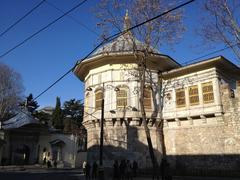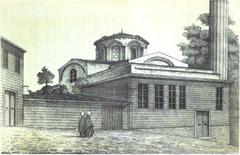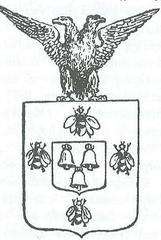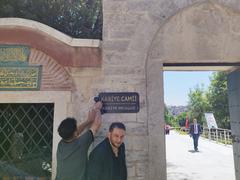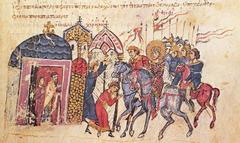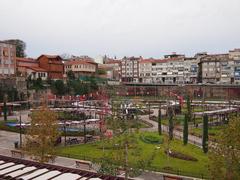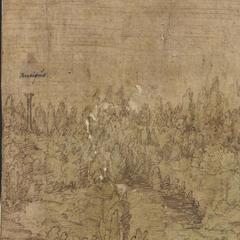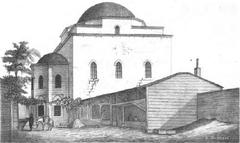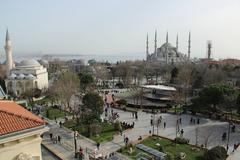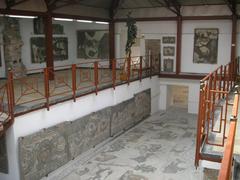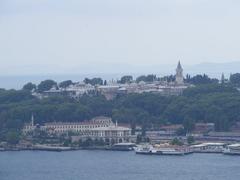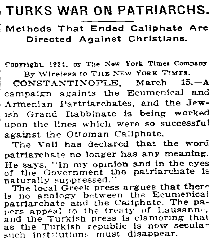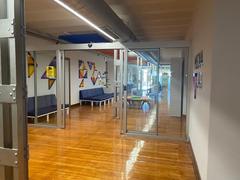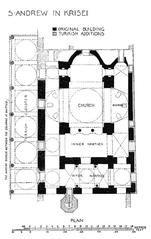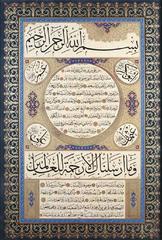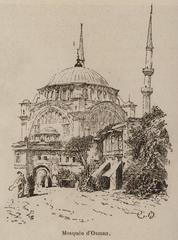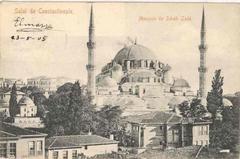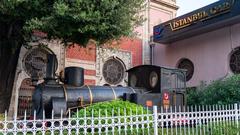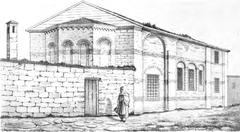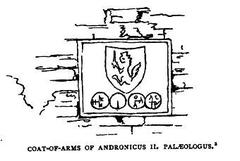Gazanfer Ağa Medresesi: Visiting Hours, Tickets, and Historical Significance in Fatih, Turkey
Date: 04/07/2025
Introduction
Nestled in Istanbul’s historic Fatih district, Gazanfer Ağa Medresesi stands as a remarkable testament to Ottoman architectural ingenuity and the city’s rich educational heritage. Established in the late 16th century by Gazanfer Ağa—a prominent palace official of Hungarian origin—this medrese (Islamic theological school) was designed by imperial architect Davud Ağa, a successor to Mimar Sinan. The complex, completed around 1596, includes not only the medrese itself but also a türbe (mausoleum), sebil (public water fountain), and hazîre (graveyard), reflecting its multifaceted role as an educational, religious, and charitable institution. Today, under the stewardship of the Aziz Mahmud Hüdayi Foundation, the medrese continues to serve as a vibrant cultural and educational center, welcoming visitors to experience Istanbul’s Ottoman legacy firsthand.
Table of Contents
- History and Patronage
- Architectural Features
- Visitor Information
- Special Events and Guided Tours
- Frequently Asked Questions (FAQs)
- Visuals and Media
- Additional Resources and Links
- Conclusion and Visitor Tips
History and Patronage
Who Was Gazanfer Ağa?
Gazanfer Ağa was a highly influential Ottoman palace official who served as chief eunuch (kapı ağası) under Sultan Murad III and Sultan Mehmed III, holding the position for an impressive 22 years (1581–1603). Of Hungarian origin, Gazanfer Ağa’s career was distinguished by his patronage of arts and architecture, culminating in the establishment of the medrese that now bears his name. His endowment furthered the Ottoman tradition of religious and educational philanthropy, contributing to the intellectual and spiritual life of Istanbul (Islam Ansiklopedisi).
The Medrese’s Foundation
Constructed following the Ottoman-Safavid wars (1578–1590), Gazanfer Ağa Medresesi was designed by chief imperial architect Davud Ağa. According to its 1596 vakfiye (endowment deed), the complex originally featured seventeen student cells and a central classroom (dershane). The medrese was envisioned as a center for advanced religious and legal studies, preparing scholars and officials for service in the Ottoman state (Kültür Envanteri).
Architectural Features
Layout and Design
Gazanfer Ağa Medresesi exemplifies late 16th-century Ottoman educational architecture. The medrese is organized around a tranquil central courtyard, with domed student cells (hücreler) set in a U-shaped arrangement on three sides. The courtyard is accessed via a main gate on Kovacılar Caddesi, leading visitors into a harmonious blend of communal and educational spaces.
Courtyard, Student Cells, and Classroom
- Student Cells: There are fifteen domed cells, each providing modest accommodation for students, complete with small windows, storage niches, and domed ceilings for temperature regulation and acoustics.
- Portico: The cells are fronted by a portico supported by marble or granite columns, each topped by a small dome, creating a rhythmic, shaded walkway.
- Dershane (Classroom/Mosque): The square-plan, domed dershane stands opposite the main entrance, slightly elevated above courtyard level. Its interior, historically adorned with painted decoration, features a mihrab facing Mecca and windows in the dome’s drum for natural light (Yeditepe Fatih).
Türbe (Mausoleum), Sebil (Fountain), and Hazîre (Graveyard)
- Türbe: Located in the northwest corner of the courtyard, the polygonal türbe houses Gazanfer Ağa’s tomb and is topped with a dome. Its windows feature decorative grilles, and it connects the founder’s legacy directly to the educational mission of the medrese.
- Sebil: At the corner of the complex, the sebil is a domed structure from which free water was distributed, embodying Ottoman traditions of public charity.
- Hazîre: Adjacent to the türbe is a small graveyard (hazîre) with tombs from the 17th century, reinforcing the site’s spiritual importance.
Construction and Decorative Elements
The medrese is built from alternating layers of cut stone and brick, with elegant stone carvings on the mihrab, calligraphic inscriptions on the sebil, and subtle painted or stenciled ornamentation within the dershane. The courtyard’s central şadırvan (ablution fountain) is octagonal and domed, reflecting the prominence of ritual purity in Islamic education.
Visitor Information
Visiting Hours and Entry Fees
- Hours: Open Tuesday to Sunday, 9:00 AM to 5:00 PM. Closed Mondays and on major Turkish public holidays.
- Entry: Admission is free of charge. Donations are welcome to support the preservation of the site.
Accessibility and Directions
- Address: Zeyrek Mahallesi, Kovacılar Sokak No: 12, Fatih, Istanbul.
- Public Transit: The nearest tram stop is Zeyrek (T1 line), about a 10-minute walk from the medrese. Several bus lines serve the area, and taxis are widely available.
- Accessibility: The main courtyard and entrance are on level ground, but some historic areas have steps or uneven surfaces. Visitors with limited mobility may need assistance.
Nearby Attractions
Combine your visit with other historic sites in the Fatih district, including:
- Bozdoğan (Valens) Aqueduct: A monumental Byzantine aqueduct adjacent to the medrese.
- Süleymaniye Mosque: One of Istanbul’s grandest Ottoman mosques.
- Grand Bazaar: The world-famous covered market.
- Zeyrek Mosque and Istanbul University Faculty of Theology: Both within walking distance.
Special Events and Guided Tours
The Aziz Mahmud Hüdayi Foundation organizes cultural events, seminars, and educational workshops at the medrese. Guided tours focusing on Ottoman architecture, history, and culture are available and can be arranged through the foundation or local tour operators. Check the official website or contact the medrese for schedules and booking information.
Frequently Asked Questions (FAQs)
Q: What are the visiting hours?
A: Tuesday to Sunday, 9:00 AM–5:00 PM. Closed on Mondays and public holidays.
Q: Is there an entrance fee?
A: No, admission is free.
Q: Are guided tours available?
A: Yes, upon request via the Aziz Mahmud Hüdayi Foundation.
Q: Is the medrese accessible for wheelchair users?
A: The main entrance and courtyard are accessible, but some areas have steps.
Q: Can I take photographs?
A: Yes, photography is generally permitted for personal use. Restrictions may apply during events or in certain areas.
Q: Are there cultural events at the medrese?
A: Yes, including public lectures, seminars, and community iftar dinners, especially during Ramadan. Check event schedules online.
Visuals and Media
For an enhanced visitor experience, include:
- Photographs of the medrese’s courtyard, domed student cells, and dershane interior.
- Images of the türbe, sebil, and Bozdoğan Aqueduct backdrop.
- Visual references to historical miniatures from Nâdirî’s Dîvân, depicting the site’s original academic life (Yeditepe Fatih).
Additional Resources and Links
- Islam Ansiklopedisi: Gazanfer Ağa Külliyesi
- Yeditepe Fatih: Tarihten Tasvire Gazanfer Ağa Medresesi
- Istanbul Tourism Website
- Kültür Envanteri: Gazanfer Ağa Medresesi
- Gezibilen: Gazanfer Ağa Medresesi
- Official Gazanfer Ağa Medresesi Website
Conclusion and Visitor Tips
Gazanfer Ağa Medresesi stands as a distinguished jewel within Istanbul’s historic Fatih district, offering visitors an immersive journey into the Ottoman Empire’s educational traditions, architectural mastery, and philanthropic spirit. With its free admission, accessible location, and ongoing cultural programming, the medrese is a must-visit for history enthusiasts, architecture lovers, and cultural travelers alike.
Visitor Tips:
- Use public transportation for convenience due to Istanbul’s traffic and limited parking.
- Visit early for a quieter experience and optimal lighting for photography.
- Explore nearby landmarks for a full day of historical discovery.
- Check the medrese’s official website for the latest on events and guided tours.
- Consider downloading the Audiala app for detailed guides to Istanbul’s historical sites.
Immerse yourself in the enduring legacy of Ottoman education and culture at Gazanfer Ağa Medresesi—where Istanbul’s illustrious past meets its vibrant present.
